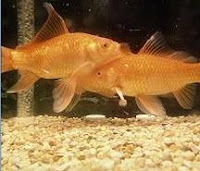.
 Ratfish
RatfishThe ratfish is a member of a species of deep-water fish related to sharks. The ratfish is characterized by a long tail and a poisonous spine in front of the dorsal fin.
 Rosy Barbel
Rosy BarbelThis fish of the genus Barbus, known as the rosy barbel, swims in a clear freshwater stream amidst the aquatic plants and roots on which it feeds. Part of the carp family, barbels live at the bottom of rivers or streams during the day and use their whiskerlike feelers, called barbels, to find food at dusk. Several species of barbels exist in western Asia and central and southern Europe, where the fish is prized in sports fishing.
 Sawfish
SawfishAlthough sharklike in appearance, sawfish are actually a type of ray and are distinguished by the presence of gill openings on the lower surface of the head rather than on the sides of the head as in sharks. The sawfish snout is elongated into a broad, flat sword with opposing rows of large teeth. When feeding, the sawfish thrashes the saw from side to side, wounding and killing small fish. Sawfish are common in the shallow coastal waters of tropical seas and can ascend moderate distances up freshwater rivers.
 Sea Horse
Sea HorseThe Hippocampus hudonius, also known as the common sea horse, is the largest of over 24 species of sea horses. Sea horses swim fastest in the horizontal position, but can also propel themselves while remaining vertical. Sea horses, like pipefish, have unusual breeding habits. Following mating, a female sea horse deposits her eggs in a brood pouch located on the abdomen of the male sea horse, who then takes care of the eggs until they hatch.
 Skipjack Tuna
Skipjack TunaSkipjack, small, fast-swimming tuna, are distinguished by the dark, horizontal lines found on their streamlined, torpedo-shaped bodies.
 Spiny Puffer
Spiny PufferThe spiny puffer, or burrfish, has a unique defensive mechanism that protects it from predators. When threatened, the spiny puffer inflates its body with water or air, which causes the numerous long spines covering the body to be erected. The inflated body and the sharp spines make it difficult for a predator to ingest the puffer. After the danger has passed, the puffer slowly deflates itself and resumes a more normal shape.
 Squirrelfish
SquirrelfishSquirrelfish are found in coral reefs throughout the tropics. They are predators, primarily eating small invertebrates such as worms, snails, and shrimp. Squirrelfish are nocturnal; at night their large eyes help them see and their reddish color helps to camouflage them from predators. During the day, they hide in crevices or caves.
 Tilapia
TilapiaFishes of the genus Tilapia are popular as both aquarium and food fishes. Some species of tilapia are mouth brooders, protecting unhatched eggs and newly hatched young by carrying the eggs and young in their mouths. Usually the female carries the offspring, but in a few species the male also participates in mouth brooding.
 White Mullet
White MulletThe white mullet, commonly found in coastal marine waters and estuaries in temperate and tropical North and Central America, is one of approximately 95 species of mullets found worldwide. White mullets filter plankton and fine particles of organic material from the water and bottom sediments with their fine, sievelike gill rakers.
 Winter Flounder
Winter FlounderThe winter flounder belongs to a group of marine fish known as flatfish. Its flattened body, with both eyes on the same side of the head, and ability to change its body coloration to match that of the immediate background make the winter flounder well adapted for a bottom-dwelling existence.




















